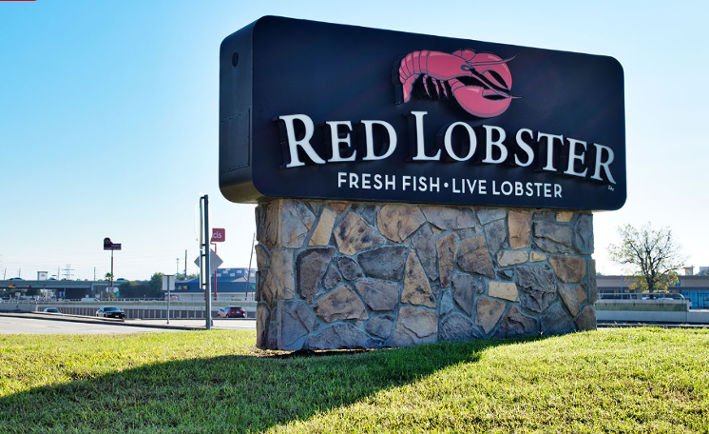
Red Lobster Flounders.Claws Out: Red Lobster’s Dive into Bankruptcy After a String of Missteps
Red Lobster, the iconic American seafood chain known for its cheddar bay biscuits and endless shrimp specials, has sunk its claws into troubled waters. The company recently filed for bankruptcy, marking a dramatic fall from grace for a restaurant once synonymous with family gatherings and celebratory feasts. This article delves into the crustacean catastrophe, exploring the missteps that led to Red Lobster’s financial undoing. Red Lobster Flounders
A Sea of Change: The Pandemic’s Impact
The COVID-19 pandemic undoubtedly played a significant role in Red Lobster’s struggles. Restrictions on dine-in services and a shift towards takeout and delivery significantly impacted the restaurant industry. Red Lobster, known for its sit-down experience, wasn’t well-positioned to adapt to this changing landscape. Their traditional menu, geared towards larger groups and special occasions, wasn’t easily translated into a delivery format. Additionally, rising food and labor costs squeezed profit margins further during this period.
A Recipe for Disaster: Questionable Decisions
While the pandemic served as a catalyst, it wasn’t the sole factor in Red Lobster’s descent. A series of questionable decisions by management contributed to the financial woes. One such misstep was the ill-fated all-you-can-eat shrimp promotion. Launched in 2020 as a way to attract customers during the pandemic, the promotion backfired spectacularly. The low price point significantly reduced profit margins, and customers overwhelmed by the endless options often wasted food. This promotion damaged Red Lobster’s reputation for quality and value.
Another questionable decision was the frequent turnover in leadership. Red Lobster cycled through several CEOs in a short period, leading to a lack of strategic direction. Without a clear vision, the company struggled to adapt to changing consumer preferences and market trends.
A Losing Battle: Competition Heats Up

The American seafood landscape has become increasingly competitive. Fast-casual seafood chains offering healthier and more affordable options have chipped away at Red Lobster’s market share. These new players catered to a younger generation with different dining preferences, further isolating Red Lobster’s core demographic.
A Losing Battle: Competition Heats Up – A Sea of New Players and Changing Preferences
The American casual dining scene, once dominated by familiar names like Red Lobster, has undergone a dramatic transformation. New players have emerged, offering a more contemporary take on seafood, and these new entrants have been steadily eroding Red Lobster’s market share.
Fast-Casual Revolution: Speed, Value, and Health
The rise of fast-casual seafood chains has been a major factor in Red Lobster’s struggles. These restaurants offer a quicker, more affordable dining experience compared to Red Lobster’s traditional sit-down format. They cater to a younger generation with different dining preferences, prioritizing convenience and value over a leisurely, full-service experience.
These fast-casual chains often focus on healthier options, featuring lighter preparations and a wider variety of seafood beyond the typical fried fare. This focus on health resonates with a growing segment of the population seeking more balanced and sustainable food choices.
Innovation on a Plate: Diverse Menus and Unique Experiences
Fast-casual chains aren’t simply replicating Red Lobster’s offerings. They’re constantly innovating, introducing new and exciting menu items that cater to diverse palates. Poke bowls bursting with fresh ingredients, creative lobster rolls, and globally inspired seafood dishes are just a few examples. This focus on variety and experimentation keeps these establishments fresh and exciting for customers, especially younger demographics less attached to traditional seafood fare.
Beyond the menu, fast-casual chains are also creating unique dining experiences. Open kitchens, interactive ordering systems, and a focus on sustainability are all elements that appeal to a generation that values transparency and social responsibility.
Targeting a Different Demographic: Millennials and Gen Z Take the Helm
Red Lobster’s core demographic has traditionally been older generations with a nostalgic attachment to the brand. However, millennials and Gen Z, with their different dining preferences and spending habits, are now the dominant consumer force. Fast-casual chains have successfully targeted these younger demographics with their contemporary approach to seafood.
Red Lobster, on the other hand, struggled to adapt its brand and offerings to resonate with these new customers. Their menu remained largely unchanged, failing to cater to the evolving desire for healthier options and diverse flavors. The traditional sit-down format also felt outdated compared to the quick and casual atmosphere offered by competitors.
By failing to adapt to the changing market and consumer preferences, Red Lobster found itself outmaneuvered by a new generation of innovative and competitive fast-casual seafood chains.
A Questionable Acquisition: Thai Union’s Influence
In 2016, Thai Union, a Thai seafood conglomerate, acquired Red Lobster’s parent company. This acquisition was met with skepticism by industry analysts. Concerns were raised that Thai Union might prioritize short-term profits over long-term investments in Red Lobster’s brand and menu. These concerns seem to have been validated. Following the acquisition, reports surfaced of cost-cutting measures that impacted the quality of ingredients and service. Additionally, the Thai Union was accused of pressuring Red Lobster to source shrimp from its own farms, a move that potentially reduced profit margins for Red Lobster.
A Glimmer of Hope? Restructuring and the Future
Despite the bankruptcy filing, a complete shutdown isn’t necessarily Red Lobster’s fate. The company is restructuring its debt and exploring various options for survival. Potential solutions include closing underperforming locations, streamlining the menu, and focusing on delivery and takeout options. The future of Red Lobster remains uncertain, but there’s a chance for a comeback if the company can learn from its missteps and adapt to the changing dining landscape.
Beyond the Buffet: Red Lobster’s Legacy
Red Lobster has been a fixture in American dining culture for decades. It’s more than just a restaurant; it evokes memories of family gatherings, birthday celebrations, and special occasions. Whether Red Lobster can weather this storm and reclaim its former glory remains to be seen. However, the company’s legacy as a symbol of American seafood dining is undeniable.







